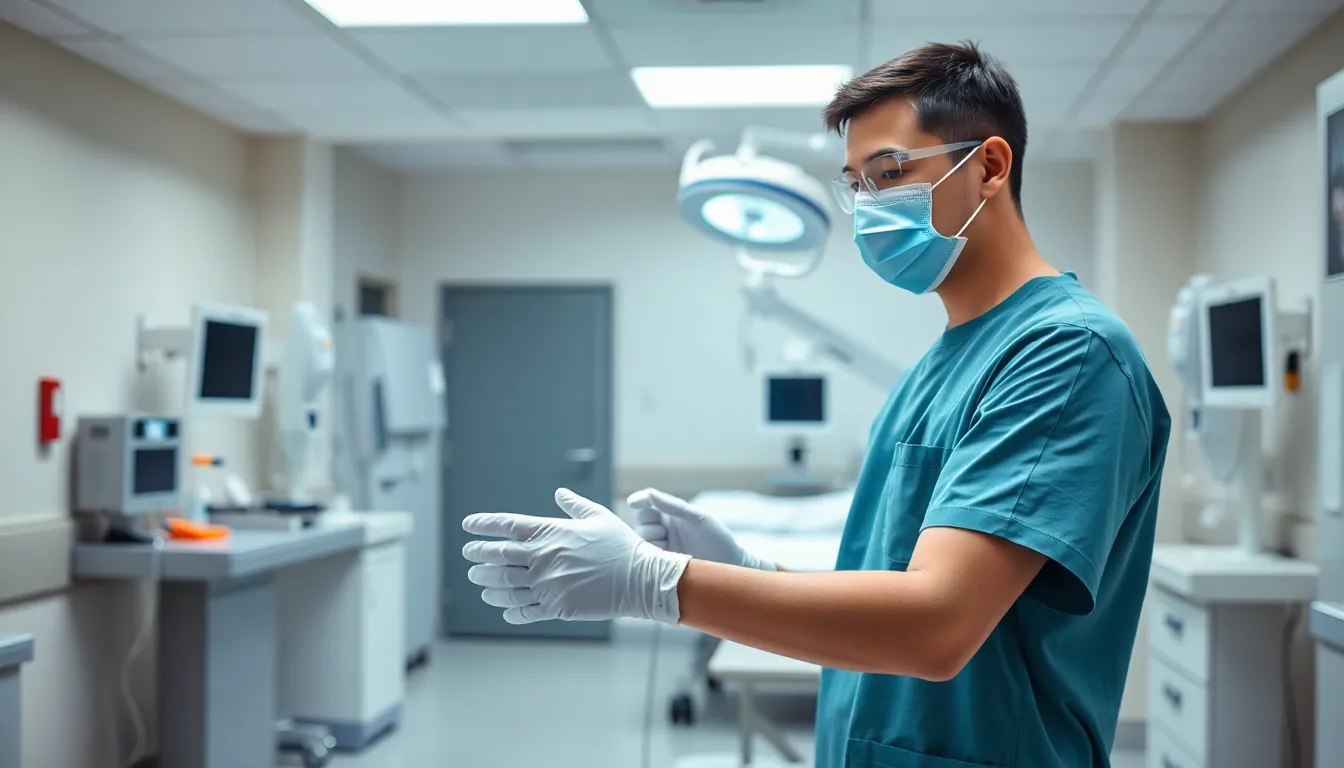Table of Contents
ToggleWhen it comes to sexually transmitted infections, most people think of the usual suspects. But what if a notorious bacteria like Pseudomonas aeruginosa crashed the party? This sneaky little germ is known for its resilience and ability to thrive in various environments, from hospital settings to your favorite swimming pool. But can it really take a leap into the realm of sexual transmission?
Before you start worrying about your next romantic rendezvous, let’s dive into the facts. Pseudomonas aeruginosa might not be your typical party crasher, but understanding its behavior and potential risks is crucial. So grab your magnifying glass and let’s explore whether this germ can join the ranks of STIs, or if it’s just here to watch the show.
Overview of Pseudomonas Aeruginosa
Pseudomonas aeruginosa is a versatile bacterium commonly found in diverse environments. This germ poses unique challenges due to its adaptability and resistance to many antibiotics.
Characteristics and Habitats
Pseudomonas aeruginosa thrives in moist conditions, often inhabiting soil, water, and human-made environments like hospitals. It’s recognized for its ability to survive in harsh environments, including those with high levels of disinfectants and extreme temperatures. Its presence is common in contaminated medical instruments, respiratory equipment, and even in wounds. Understanding these habitats helps in recognizing potential sources of infection, especially in healthcare settings.
Common Infections Caused
Pseudomonas aeruginosa can cause a variety of infections, particularly in individuals with weakened immune systems. Common infections include pneumonia, urinary tract infections, and skin infections. The bacterium is notorious for treating wounds, especially burns, and can lead to serious complications in patients with cystic fibrosis. Prompt identification and treatment of these infections are crucial to preventing severe health outcomes, particularly in vulnerable populations.
Transmission Methods

Pseudomonas aeruginosa’s transmission methods require careful examination to understand the risks involved. Significant knowledge exists about bacterial transmission, especially concerning its spread in environments and human interactions.
Understanding Bacterial Transmission
Bacteria can spread through various means, including direct contact, airborne particles, and contaminated surfaces. Understanding how these microorganisms operate helps determine potential risks in different settings. Individuals often become infected by touching contaminated items and then transferring pathogens to mucous membranes through hand contact. In environments like hospitals, where Pseudomonas aeruginosa thrives, the risk significantly increases, especially for those with compromised immune systems. As a result, awareness and adherence to hygiene protocols are crucial for preventing transmission.
Modes of Transmission for Pseudomonas Aeruginosa
Transmission of Pseudomonas aeruginosa mainly occurs through direct contact and environmental exposure. This bacterium can survive on various surfaces and even in water, making these common vectors for infection. Individuals at risk include those with open wounds or indwelling devices, as moisture can harbor bacteria. It can also flourish in inhaled aerosols from contaminated water devices, highlighting the importance of monitoring respiratory equipment in healthcare settings. Consequently, maintaining rigorous cleanliness standards is essential for infection control.
Can Pseudomonas Aeruginosa Be Sexually Transmitted?
Pseudomonas aeruginosa, a versatile bacterium, raises questions regarding its potential for sexual transmission. Current research indicates it is not classified as a sexually transmitted infection.
Current Research Findings
Research findings consistently show Pseudomonas aeruginosa primarily spreads through direct contact and environmental exposure rather than sexual activities. Studies suggest the bacterium thrives in moist, nonsexual environments. Limited data supports infection transmission through intimate contact, marking it as rare. Individuals with cuts or wounds present higher susceptibility, yet sexual transmission remains unlikely. The emphasis on environmental hygiene reinforces the notion that infections commonly arise from contaminated surfaces and healthcare settings.
Expert Opinions
Experts largely agree that Pseudomonas aeruginosa isn’t categorized among traditional STIs. They highlight its environmental resilience and potential for healthcare-associated infections instead. Medical professionals point out that while the bacterium can colonize the human body, sexual encounters don’t significantly heighten transmission risks. Many experts stress the importance of proper hygiene practices in preventing infections, particularly around open wounds. Furthermore, their consensus underscores the necessity for awareness regarding environmental routes rather than sexual means of transmission.
Risk Factors and Vulnerable Populations
Specific risk factors elevate the likelihood of Pseudomonas aeruginosa infections. Individuals with weakened immune systems face greater vulnerability due to their body’s reduced ability to fend off infections. Healthcare settings pose significant risks, particularly for patients undergoing invasive procedures.
Moist environments further enhance the possibility of exposure, as Pseudomonas aeruginosa thrives in such conditions. Individuals with open wounds or indwelling medical devices consistently encounter higher transmission risks. A recent study indicates that individuals in long-term care facilities are particularly susceptible due to shared living spaces and limited hygiene measures.
Chronic illnesses, such as cystic fibrosis or diabetes, also contribute to increased susceptibility. Patients with cystic fibrosis often require frequent hospital visits, which can lead to repeated exposure to the bacterium. In addition, those undergoing treatment for cancer or receiving immunosuppressive therapy face heightened risks as their immune defenses weaken.
Environmental factors should not be overlooked. Contaminated water sources and surfaces in public areas can harbor the bacteria. Regular cleaning and disinfection of spaces frequented by vulnerable populations are crucial for preventing transmission.
Effective hygiene practices also play a vital role in minimizing risks. Thorough handwashing can significantly reduce the likelihood of infection. By emphasizing the importance of cleanliness, healthcare providers can protect patients and staff alike.
Understanding these risk factors and vulnerable populations aids in implementing strategies to mitigate the spread of Pseudomonas aeruginosa. Recognizing high-risk individuals will allow for targeted prevention efforts, enhancing overall public health.
Preventative Measures and Recommendations
Effective hygiene practices play a crucial role in preventing infections caused by Pseudomonas aeruginosa. Regular handwashing with soap for at least 20 seconds can significantly reduce the risk of transmission. Clean surfaces frequently, particularly in areas that retain moisture, such as bathrooms and kitchens. Preventive measures should include using disinfectants known to be effective against this resilient bacterium.
Individuals with open wounds and indwelling devices must pay extra attention to hygiene. Keeping wounds properly covered and clean helps minimize exposure to potential contaminants. It’s advisable to avoid sharing personal items, such as towels or razors, that can harbor bacteria. Using personal protective equipment in healthcare settings isn’t just beneficial; it’s essential for reducing risks of infection.
Maintaining a clean environment contributes to overall safety. Regularly disinfecting medical equipment and ensuring proper sterilization techniques in healthcare facilities helps prevent outbreaks. In homes, especially for those with weakened immune systems, frequent cleaning of shared spaces reduces the chances of environmental exposure.
Monitor chronic illnesses closely to mitigate infection risks. Individuals suffering from conditions like cystic fibrosis or those undergoing invasive procedures should adhere to guidelines prescribed by healthcare professionals. Consulting with specialists can provide tailored advice on managing health risks while remaining aware of environmental factors such as contaminated water sources.
Awareness of the unique challenges posed by Pseudomonas aeruginosa enables better prevention strategies. Keeping informed about the latest hygiene recommendations and safety standards fosters a proactive approach to health. Implementing these preventative measures effectively creates safer environments and enhances community health.
Pseudomonas aeruginosa isn’t classified as a sexually transmitted infection. Its transmission primarily occurs through direct contact and environmental exposure rather than intimate encounters. Understanding the bacterium’s behavior and the risks associated with it is essential for maintaining health and safety.
Individuals should focus on effective hygiene practices to minimize the risk of infection. This includes regular handwashing and cleaning of shared surfaces. For those with weakened immune systems or chronic conditions, taking extra precautions is vital. By staying informed and practicing good hygiene, communities can better protect themselves from infections linked to Pseudomonas aeruginosa.







